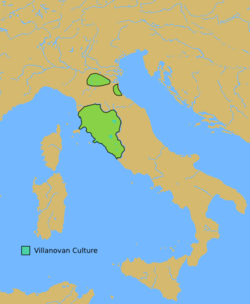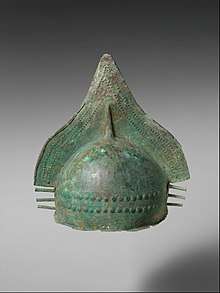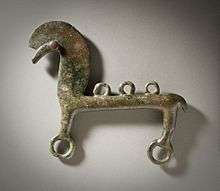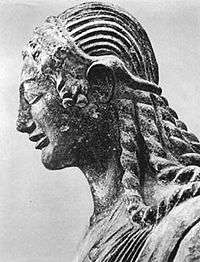Villanovan culture
 | |
| Geographical range | Europe (Northern-Central Italy: Emilia-Romagna, Tuscany, Lazio) |
|---|---|
| Period | Early Iron Age |
| Dates | c. 1100 BC – 700 BC |
| Preceded by | Proto-Villanovan culture |
| Followed by | Etruscan civilization |
| Iron Age |
|---|
| ↑ Bronze Age |
|
Ancient Near East (1200 – 550 BC)
South Asia (1200 – 200 BC) East Asia (500 BC – AD 300) |
| ↓ Ancient history |
| Historiography |
The Villanovan culture was the earliest Iron Age culture of Central Italy and Northern Italy, abruptly following the Bronze Age Terramare culture and giving way in the 7th century BC to an increasingly orientalizing culture influenced by Greek traders, which was followed without a severe break by the Etruscan civilization. The Villanovan culture and people branched from the Urnfield culture of Central Europe.[1] The Villanovans introduced iron-working to the Italian Peninsula; they practiced cremation and buried the ashes of their dead in pottery urns of distinctive double-cone shape.
The name Villanovan comes from the type-site, that of the first archaeological finds relating to this advanced culture, remnants of a cemetery found near Villanova (Castenaso, 8 kilometers south-east of Bologna) in northern Italy. The excavation lasting from 1853 to 1855 was made by the scholarly owner, count Giovanni Gozzadini, and involved 193 tombs, six of which were separated from the rest as if to signify a special social status. The "well tomb" pit graves lined with stones contained funerary urns; they had been only sporadically plundered, and most were untouched. In 1893, a chance discovery unearthed another distinctive Villanovan necropolis at Verucchio, overlooking the Adriatic coastal plain.
The burial characteristics relate the Villanovan culture to the Central European Urnfield culture (c. 1300–750 BC), and Celtic Hallstatt culture (which succeeded the Urnfield culture), in such a way that it is not possible to tell them apart in their earlier stages. Cremated remains were placed in cinerary urns, specifically in biconical urns[2] and then buried. The urns were a form of Villonovan pottery known as impasto.[2] A custom believed to originate with the Villanovan culture is the usage of "Hut urns", cinerary urns fashioned like small huts, and other advanced urn designs. Typical sgraffito decorations of swastikas, meanders, and squares were scratched with a comb-like tool. Urns were accompanied by simple bronze fibulae, razors and rings.
Metalwork and trade
The metalwork quality found in bronze and pottery show commitment by Villanovan artisans. Some grave goods from burial sites display a higher quality, suggesting the development of societal elites within Villanovan culture. Tools and items were placed in graves suggesting a belief in an afterlife, men's graves contained weapons, armor, weaving tools for the women with a few graves containing vice versa goods. Indicating exceptions with the possibility that women played a more active role in Villanovan culture and that men too had made clothing. [3]
Villanovans traded with other states from the Mediterranean such as Greeks, Balkans, and Sardinia. Trade brought about advancement in metallurgy, and Greek presence influenced Villanovan pottery.[3]
Housing

Housing was rectangular in shape. The people lived in small huts, made of wattle and daub with wooden poles for support. Within the huts, contained cooking stands, utensils and charred animal bones indicate the family life of early inhabitants in Italy.[4] Some Huts contained large pottery jars for food storage sunk into their floors, there was also rock cut drainage to channel rainwater to communal reservoirs. [5]
Periodization
The culture is broadly divided into a Proto-Villanovan culture (Villanovan I) from c. 1100 BC to c. 900 BC and the Villanovan culture proper (Villanovan II) from c. 900 BC to c. 700 BC. This period came just before the foundation of Etruscan cities.
The later phase (Villanovan II) saw radical changes, evidence of contact with Hellenic civilization and trade with the north along the Amber Road: glass and amber necklaces on women, bronze armor and horse harness fittings, and the development of elite graves in contrast to the earlier egalitarian culture. Chamber tombs and inhumation (burial) practices were developed side-by-side with the earlier cremation practices.
Range

Generally speaking, Villanovan settlements were centered in the Adriatic Etruria, in Emilia Romagna (in particular, in Bologna and in Verucchio, near Rimini), in Tuscany, in Lazio, and in Marche (Fermo). Further south, Villanovan cremation burials are to be found in Campania, at Capua, at the "princely tombs" of Pontecagnano near Salerno,[6] at Capo di Fiume, at Vallo di Diano and at Sala Consilina. Small scattered Villanovan settlements have left few traces other than their more permanent burial sites, which were set somewhat apart from the settlements— largely because the settlement sites were built over in Etruscan times. This site continuity encourages modern opinion generally to follow Massimo Pallottino in regarding the Villanovan culture as ancestral to the Etruscan civilization.
Issues of identity
The traces of cultural evidence available suggest that there may not have been a single, widespread ethnic group directly equivalent to the Villanovan material culture, according to archaeologist Renato Peroni.
Villanovan sites tend to underlie sites with both Celtic and Italic ethnolinguistic provenance, adding to the difficulties in assessing a precise cultural identification. The many shared features of the Celtic and Italic languages have led most linguists to accept that they once formed a discrete Italo-Celtic language group, although there is no agreement as to whether this resulted from: a shared ancestral language with a specific geographical origin (i.e. "Proto-Italo-Celtic"), a series of areal features resulting from language contact, or both. (Hence the Villanovan sites cannot yet be accurately described as "Italo-Celtic".)
| Wikimedia Commons has media related to Villanovian culture. |
See also
Notes
- ↑ "Villanovan culture". Encyclopædia Britannica.
- 1 2 Soren, David; Martin, Archer (2015). Art and Archaeology of Ancient Rome. Midnight Marquee Press, Incorporated. p. 9.
- 1 2 "Villanovan Culture". Ancient History Encyclopedia. Retrieved 2018-04-09.
- ↑ Cary, Max; Scullard, H. H. (1975-06-18). History of Rome: Down to the Age of Constantine. Springer. p. 13. ISBN 9781349024155.
- ↑ "Villanovan Culture". Ancient History Encyclopedia. Retrieved 2018-04-09.
- ↑ Pontecagnano finds are conserved in the Museum of Agro Picentino.
Sources and further reading
- S. Gozzadini: La nécropole de Villanova, Fava et Garagnani, Bologna, 1870
- J. P. Mallory, "Villanovan Culture", Encyclopedia of Indo-European Culture, (Fitzroy Dearborn), 1997.
- G. Bartoloni, "The origin and diffusion of Villanovan culture." in M. Torelli, (editor) The Etruscans, pp 53–74. (Milan), 2000.
- M.E. Moser, The "Southern Villanovan" Culture of Campania, (Ann Arbor), 1982.
- D. Ridgway, "The Villanovan Cemeteries of Bologna and Pontecagnano" in Journal of Roman Archaeology 7: pp 303–16 (1994)
External links
| Wikisource has the text of the 1911 Encyclopædia Britannica article Villanova. |
